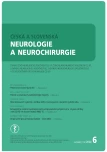Clonal hematopoiesis of indeterminate potential in ischemic stroke – study protocol
Authors:
M. Haršány 1,2; V. Kunešová 1; B. Kalousová 3; R. Slavkovský 3; J. Drábek 3,4; J. Stránská- 3 5; M. Hajdúch 3; R. Mikulík 1,2
Authors‘ workplace:
Mezinárodní centrum klinického výzkumu, FN u sv. Anny v Brně
1; I. neurologická klinika LF MU a FN u sv. Anny v Brně
2; Ústav molekulární a translační medicíny, LF UP, Olomouc
3; Laboratoř experimentální medicíny, FN Olomouc
4; Neurologická klinika FN Olomouc
5
Published in:
Cesk Slov Neurol N 2022; 85(6): 496-500
Category:
Original Paper
doi:
https://doi.org/10.48095/cccsnn2022496
Overview
Aim: The exact relationship between the gene mutation of hematopoietic cells (clonal hematopoiesis of indeterminate potential; CHIP) and the clinical manifestation has not yet been clearly described. The aim of this academic multicentric clinical study is to investigate the association between the presence of CHIP in peripheral blood and the incidence of ischemic stroke, and at the same time, to demonstrate whether CHIP contributes to the etiopathogenesis of atherosclerosis. This could lead to the identification of a new potential risk factor in the diagnosis of ischemic stroke predisposition. Methodology: This is a multicenter prospective study involving 14 primary and comprehensive stroke centers in the Czech Republic. The total number of enrolled patients aged ≥ 70 years is expected to be 1,000. The selected surgical centers will collaborate to provide 50 atherosclerotic plaque samples. Monitored parameters include personal and pharmacological history, laboratory parameters, neurological parameters, and results of selected imaging examinations. The expected outcome will be the definition of specific allelic variants and their frequencies as risk factors for the development of atherosclerosis and subsequent manifestation of ischemic stroke.
Keywords:
stroke – Mutation – Hematopoiesis – Atherosclerosis – ischemia – cell clones
Sources
1. Kusne Y, Xie Z, Patnaik MM. Clonal hematopoiesis: molecular and clinical implications. Leuk Res 2022; 113: 106787. doi: 10.1016/j.leukres.2022.106787.
2. Gibson JCh, Steensma DP. New insights from studies of clonal hematopoiesis. Clin Cancer Res 2018; 24 (19): 4633–4642. doi: 10.1158/1078-0432.CCR-17-3044.
3. Zink F, Stacey SN, Norddahl GL et al. Clonal hematopoiesis, with and without candidate driver mutations, is common in the elderly. Blood 2017; 130 (6): 742–752. doi: 10.1182/blood-2017-02-769869.
4. Jaiswal S, Fontanillas P, Flannick J et al. Age-related clonal hematopoiesis associated with adverse outcomes. N Engl J Med 2014; 371 (26): 2488–2498. doi: 10.1056/NEJMoa1408617.
5. Jaiswal S, Natarajan P, Silver AJ et al. Clonal hematopoiesis and risk of atherosclerotic cardiovascular disease. N Engl J Med 2017; 377 (2): 111–121. doi: 10.1056/NEJMoa1701719.
6. Xie M, Lu C, Wang J et al. Age-related mutations associated with clonal hematopoietic expansion and malignancies. Nat Med 2014; 20 (12): 1472–1478. doi: 10.1038/nm.3733.
7. Genovese G, Kähler AK, Handsaker RE et al. Clonal hematopoiesis and blood-cancer risk inferred from blood DNA sequence. N Engl J Med 2014; 371 (26): 2477–2487. doi: 10.1056/NEJMoa1409405.
8. Murray PJ, Wynn TA. Protective and pathogenic functions of macrophage subsets. Nat Rev Immunol 2011; 11 (11): 723–737. doi: 10.1038/nri3073.
9. Nidorf SM, Aernoud TLF, Mosterd A et al. Colchicine in patients with chronic coronary disease. N Engl J Med 2020; 383 (19): 1838–1847. doi: 10.1056/NEJMoa2021372.
10. Tardif JC, Kouz S, Waters DD et al. Efficacy and safety of low-dose colchicine after myocardial infarction. N Engl J Med 2019; 381 (26): 2497–2505. doi: 10.1056/NEJM oa1912388.
Labels
Paediatric neurology Neurosurgery NeurologyArticle was published in
Czech and Slovak Neurology and Neurosurgery

2022 Issue 6
Most read in this issue
- Guidelines for developmental dysphasia – version 2022
- Validation study and introduction of the new TEPO sentence comprehension test for children aged 3–8 years
- New pharmacological options in the treatment of Alzheimer‘s disease
- Limb girdle muscular dystrophies
